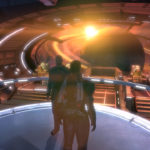This is where the helm, Captain, and many of the top officers are.
–
Table of Contents:
- Introduction
- Flag Bridge
- Locations
- Capacities
- Layout
- Access
- Special Features
- Conceptual Images
–
Introduction:
The Bridge of any ship is the command nerve center where orders are issued out to the rest of the ship through direct vocal, electronic, photonic, and digital machine languages. It is here that the Captain or acting-Captain will commonly remain during any operations demanding his constant attention. The Bridge is entirely utilitarian and spartan in both its nature and construct.
–
Flag Bridge:
Far more comfortable and homey, this secondary, augment-Bridge is strictly reserved for the Captain and any Flag Officers visiting or residing about the ship. Although commands for the rest of the ship may be issued as easily from the Flag Bridge as the main Bridge, this module of the ship is more often used for executive-tier over-watch, sight-seeing, and socializing.
The most-senior officers in the Navy are known as flag-officers. The phrase “general and flag officers” or “GFOs” refers to all officers in paygrades O-7 through O-10, thus including one-star, two-star, three-star, and four-star officers; admirals.
–
Locations:
These two bridges are usually very close to each other, if not adjacent, in most similarly-designed ships.
In TNH’s case, since it was designed by the same man who designed most Inisfreean vessels, these Bridges are deep inside the hull, but nowhere near the reactor or other potentially-risky/harmful areas/devices. This helps ensure that even heavy attacks, or the destabilization of part of the reactor, are unlikely to damage or even distract the people in these rooms. Even accidental bombs or missiles firing/detonating inside one of the hangars would be too far away to threaten or delay the tasking of the officers in these two rooms.
Their locations obviously prevent them from using/having normal portholes/windows, but extremely-reliable viewing-screens are in them, and are arranged and connected/linked in such a way as to produce a lifelike OmniMax-level effect.
–
Capacities:
Both of these rooms/modules are spacious enough to seat ~a dozen people; each has 11 chairs secured/bolted to their floors.
- Captain (an Admiral, in this case, as this is a capital ship always escorted by a fleet)
- Executive Officer (XO, sometimes called First Officer)
- Chief of Engineering; reactor, mechanical, etc.
- Communications Officer / Chief of Intelligence
- Weapons/Tactical Officer
- the Officer of the Deck (OoD); in charge during his watch/shift, at least of some things when the Captain is there, and nearly all things when the Captain is away.
- sometimes a Junior Officer of the Deck to assist the OoD
- a Quartermaster; a Petty Officer to help with navigation and keeping the ship’s log
- a Boatswain-mate of the Watch; in charge of the other enlisted watch-standers –He also ensures that the people under him are rotated their positions every 15 minutes to help keep them alert.
- the Helmsman; actually steers the ship
- the Lee Helmsman; controls the ship’s speed
–
Layout:
Both Bridges have the same layout;
- Captain on the center chair
- XO and OoD to the Captain’s sides
- Weapons Officer and Helmsman side by side, in front of the Captain
- all other chairs in a semi-circle behind the Captain’s chair, the sides of this semi-circle formation of chairs nearly reaching the outer sides of the Weapons and Helmsman chairs; similar to a Starfleet bridge
Since both are identical, the main Bridge is usually used during wartime and first-contact operations, and the Flag Bridge is usually just an emergency backup incase the main somehow gets damaged or interfered with.
–
Access:
Only Auz, the Captain (Admiral) of TNH, and those they personally approve, are allowed anywhere near, let alone inside, either of these rooms.
–
Special Features:
Both of these rooms can show not only digital views of the outside of the carrier, but looking through the carrier as if its structure is rendered transparent. This is made possible by even more cameras and other sensors inside it than there are looking out from its exterior. Whenever there is an issue that is important enough for the officers in the Bridge/s to want to know/see more about, they activate that feature and are presented with visuals that look like they are somehow magically peering straight out through the Bridge walls… right toward the area inside their ship that needs their attention, all issues and potential/reported issues highlighted/outlined in various ways.
This is, as you might imagine, particularly useful for dealing with spies/intruders trying to sneak around.
It also lets them instantly spot anyone anywhere having a quicky in a place they might not be meant to have quickies in; imagine being able to instantly see everyone in your entire ship, no matter how far away or in the actual unlit-dark they are. It even lets these officers see inside all of their docked issued ships; those which came as part of this carrier’s complement (excepting inside Persephone, of course).
–
–





